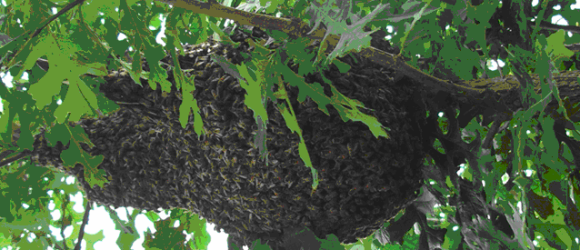Honey Bee Swarm Season
- At March 14, 2016
- By SLNA Admin
- In Nature
 0
0

Add this to the March excitement of Spring Break and SXSW – it’s honey bee swarm season! At least honey bees don’t add to our traffic woes. Our IPM Program Specialist, Wizzie Brown, clues us in to what’s happening with honey bees in the spring time, and what to watch out for. Let us know if you spot any swarms in the neighborhood!
Honey bee swarms
Honey bees are beneficial by producing honey, wax and pollinating crops. With warmer temperatures, honey bees are becoming more active and may soon begin to swarm.
Honey bee swarms look like a large clump of bees clustered together. The swarm may stay in a location from a few hours to a week. Swarms are produced as a part of the colony’s reproductive process. An established colony produces a new queen, causing the old queen and half the worker bees to leave the colony to search for a new nesting location. Swarming honey bees are usually gentle and unlikely to sting. Swarms are not protecting their home, food or offspring. Scout bees are sent out from the swarm to search for a nesting site. Colonies produce comb and honey and are defensive. Bees from a colony are more likely to sting as they are guarding their home, food and offspring.
Sometimes, honey bee colonies can be found in wall voids, chimneys, attics or sheds. If bees are in a wall void, DO NOT block their entrance; this makes them search for another way to exit and could lead bees into the structure. To keep bees from entering a home, seal any holes found in walls where pipes enter the home, cracks in window framing, knotholes, weep holes, or cracks between wood and brick junctures.
While many enjoy having honey bees around, some people are severely allergic to their venom. This, along with other situations, such as bees located near sensitive areas (such as playgrounds) may require removal or even extermination of the bees.
People should NOT try remove or exterminate bees on their own. Beekeepers and pest control companies have equipment to carry out these jobs in a safe manner. The city or county does not provide bee removal services.
For more information or help with identification, contact Wizzie Brown, Texas AgriLife Extension Service Program Specialist at 512.854.9600. Check out my blog at www.urban-ipm.blogspot.com





